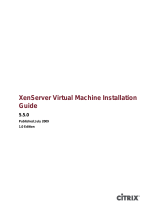
Dell EMC PowerVault ME4 Series and Citrix XenServer | H18237
Contents
Revisions................................................................................................................................................................................ 2
Acknowledgements ................................................................................................................................................................ 2
1
Introduction ...................................................................................................................................................................... 4
1.1
Scope ..................................................................................................................................................................... 4
1.2
Audience ................................................................................................................................................................ 4
1.3
Document conventions .......................................................................................................................................... 4
1.4
Terminology ........................................................................................................................................................... 5
2
Citrix XenServer and Dell Storage product overview ...................................................................................................... 7
2.1
Citrix XenServer ..................................................................................................................................................... 7
2.2
Dell EMC PowerVault ME4 Series storage ........................................................................................................... 7
3
XenServer storage overview ........................................................................................................................................... 9
3.1
Shared iSCSI storage ............................................................................................................................................ 9
3.2
Shared SAS/Fibre Channel storage .................................................................................................................... 10
3.3
SR-to-VM mapping .............................................................................................................................................. 10
3.4
Multipathing ......................................................................................................................................................... 10
4 XenServer storage using Open-iSCSI initiator (software) ............................................................................................. 13
4.1
Open-iSCSI initiator setup with Dell EMC PowerVault ME4 Series arrays ......................................................... 14
4.2
Multipath with dual subnets ................................................................................................................................. 15
4.3
Identify Dell EMC PowerVault ME4 Series storage iSCSI targets ...................................................................... 20
4.4
Configure Host Initiators in PowerVault Manager ............................................................................................... 21
4.5
Creating a Storage Repository (SR) using iSCSI ................................................................................................ 25
5 XenServer Storage using SAS/Fibre Channel HBA ...................................................................................................... 26
5.1 Configure Server Objects in PowerVault Manager .............................................................................................. 26
5.2 Create SR with hardware HBA (SAS and FC) .................................................................................................... 28
6 Creating & Mapping additional Volumes on Dell EMC PowerVault ME4 via PowerVault Manager ............................. 32
6.1 Creating a Volume: ........................................................................................................................................................ 32
6.2 Mapping the Volume: .................................................................................................................................................... 32
6.3 Verify multipath status ................................................................................................................................................... 34
A
Technical support and resources .................................................................................................................................. 35





















